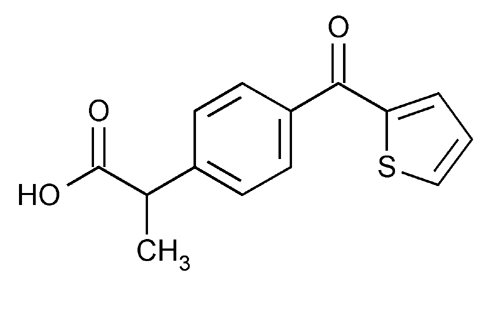Suprofen
Benzeneacetic acid,
p-2-Thenoylhydratropic acid
» Suprofen contains not less than 98.0 percent and not more than 102.0 percent of C14H12O3S, calculated on the dried basis.
Packaging and storage—
Preserve in well-closed containers.
Clarity of solution—
Dissolve 50 mg in 10 mL of 0.1 N sodium hydroxide: the solution is clear and free of undissolved solid.
Identification—
Solution:
10 µg per mL.
Medium:
0.1 N hydrochloric acid in isopropyl alcohol (10 in 100).
Respective absorptivities at 267 nm and 297 nm, calculated on the dried basis, do not differ by more than 3.0%.
Ratio:
A267 / A297, between 0.97 and 1.03.
Loss on drying  731
731 —
Dry it in vacuum at 70
—
Dry it in vacuum at 70 for 4 hours: it loses not more than 0.5% of its weight.
for 4 hours: it loses not more than 0.5% of its weight.
Residue on ignition  281
281 —
Add 1 mL of sulfuric acid to 500 mg of the test substance in the crucible, heat gently to char the substance, and ignite: the limit is 0.2%.
—
Add 1 mL of sulfuric acid to 500 mg of the test substance in the crucible, heat gently to char the substance, and ignite: the limit is 0.2%.
Heavy metals, Method II  231
231 :
0.002%.
:
0.002%.
Ordinary impurities  466
466 —
—
Test solution:
chloroform.
Standard solution:
chloroform.
Eluant:
a mixture of chloroform, methanol, and methyl ethyl ketone (40:30:30).
Visualization:
1.
Assay—
Buffer solution—
Dissolve 7.1 g of anhydrous dibasic sodium phosphate in about 800 mL of water, adjust with phosphoric acid to a pH of 6.0 ± 0.1, dilute with water to make 1000 mL of solution, and mix.
Mobile phase—
Prepare a suitable degassed and filtered mixture of Buffer solution and methanol (60:40). Make adjustments if necessary (see System Suitability under Chromatography  621
621 ).
).
Standard preparation—
Transfer about 50 mg of USP Suprofen RS, accurately weighed, to a 50-mL volumetric flask, dilute with methanol to volume, and mix. Transfer 5.0 mL of this solution to a 25-mL volumetric flask, dilute with Buffer solution to volume, and mix. Transfer 2.0 mL of this solution to a 25-mL volumetric flask, dilute with Buffer solution to volume, and mix to obtain a solution having a known concentration of about 0.016 mg per mL.
Assay preparation—
Transfer about 50 mg of Suprofen, accurately weighed, to a 50-mL volumetric flask, dilute with methanol to volume, and mix. Transfer 5.0 mL of this solution to a 25-mL volumetric flask, dilute with Buffer solution to volume, and mix. Transfer 2.0 mL of this solution to a 25-mL volumetric flask, dilute with Buffer solution to volume, and mix.
Chromatographic system—
The liquid chromatograph is equipped with a 254-nm detector and a 4.6-mm × 25-cm column that contains packing L1. The flow rate is about 2 mL per minute. Chromatograph the Standard preparation, and record the peak responses as directed for Procedure: the column efficiency determined from the analyte peak is not less than 500 theoretical plates, the tailing factor for the peak is not more than 2.0, and the relative standard deviation for replicate injections is not more than 2%.
Procedure—
[note—Use peak areas where peak responses are indicated.] Separately inject equal volumes (about 20 µL) of the Standard preparation and the Assay preparation into the chromatograph, record the chromatograms, and measure the responses for the major peaks. Calculate the quantity, in mg, of C14H12O3S in the portion of Suprofen taken by the formula:
3125C(rU / rS)
in which C is the concentration, in mg per mL, of USP Suprofen RS in the Standard preparation, and rU and rS are the peak responses obtained from the Assay preparation and the Standard preparation, respectively.
Auxiliary Information—
Please check for your question in the FAQs before contacting USP.
Chromatographic Column—
| Topic/Question | Contact | Expert Committee |
| Monograph | Clydewyn M. Anthony, Ph.D.
Scientist 1-301-816-8139 |
(MDCCA05) Monograph Development-Cough Cold and Analgesics |
| Reference Standards | Lili Wang, Technical Services Scientist 1-301-816-8129 RSTech@usp.org |
USP32–NF27 Page 3644
Chromatographic columns text is not derived from, and not part of, USP 32 or NF 27.
